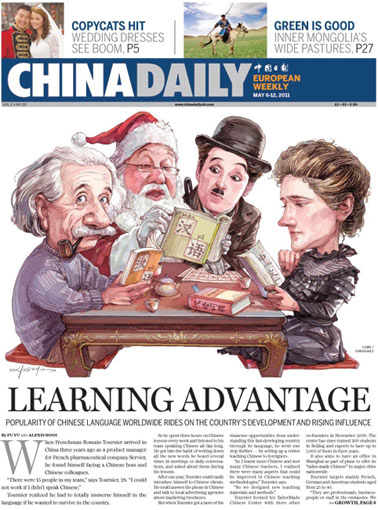Op-Ed Contributors
Will China excel US in 2016?
Updated: 2011-05-11 07:55
By Lee Il Houng (China Daily)
The publication of the latest World Economic Outlook (WEO) last month by the International Monetary Fund (IMF) has drawn much attention for an unexpected reason. According to the half-yearly WEO report, China's GDP is expected to surpass that of the United States by 2016. Less attention is paid, however, to the measure in which this comparison is made.
When comparing the value of different countries' output, each country's statistics in local currency must be converted into a common currency. However, the selection of a measure for the conversion depends on what one wants to compare.
In the WEO, the IMF uses the purchasing power parity (PPP)-adjusted GDP. This is a yardstick that tries to measure the total volume of goods and services produced in one country with that of another. To do so, currencies are converted using the PPP exchange rate, which is a relative price that ensures the same purchasing power of broadly similar basket of goods and services across countries.
Why would the conversion based on the market exchange rate not ensure the same purchasing power? There are many possible reasons, including different levels of development, quality of products that are not fully reflected in prices, and household preferences. For example, the price of a traded good that can flow freely across borders such as a computer (after adjustments for transportation and taxes) should be broadly similar across countries. However, the price of a non-traded product such as a haircut or eating out could be different. Different preferences assign different relative values to products specific to each country.
Furthermore, during the development stage, productivity of the non-traded sector is usually lower than that of the traded sector. Since prices of the traded sector should be broadly similar between a developing and a developed economy, the average price of goods and services in developing countries is usually below that in developed economies.
How would a PPP-adjusted GDP differ from a market exchange rate-based GDP comparison across countries? We would expect to see countries with greater gap between prices of non-traded and traded products, and countries with larger non-traded sectors gain most in a PPP-based comparison. Moreover, since PPP is measuring the actual volume of goods and services provided, it is generally regarded as a better measure of social welfare.
Let us now turn to China and the US. Last year, China's GDP using the market exchange rate was 40 percent of the US' GDP and, according to the latest WEO, it will reach 60 percent by 2016. This is because China's GDP growth is expected to be about three times faster than that of the US. This outlook is no surprise. It simply reflects the dynamism found in China as well as in several other emerging economies.
In terms of the PPP-adjusted GDP, the expected catch-up is more pronounced. China is estimated to have already reached 70 percent of the US' GDP and expected to surpass that of the US by 2016. Given the larger base of the PPP-adjusted GDP, the same growth rate differential noted earlier will push the GDP above that of the US by 2016.
On the other hand, the increase in the US' per capita GDP will still be larger at both market and PPP exchange rates, since the US population is less than a quarter of that of China and at the starting point, the US' per capita GDP is more than six times higher. Thus a slower growth rate in the US will still imply a faster increase in the income level of US citizens.
Is there any advantage in using the market exchange rate instead for GDP comparison? Indeed, if the objective is to measure the actual size of countries' GDP as assessed or valued by the market, notwithstanding the price distortions because of administrative or policy measures, then the market exchange rate is a more accurate measure. For example, if people are willing to pay and provide a haircut for $10, then that is the actual value of that service in that country even if people in another country are willing to pay $20 per haircut.
More generally, the market exchange rate is a more appropriate measure where financial flows between countries are involved, such as comparing current account balances.
There are other pros and cons to both measures. Market exchange rates tend to be much more volatile than PPP exchange rates. For example, a country whose market exchange rate depreciates by 30-40 percent following a balance of payment crisis will see its relative income size shrink by the same amount. This is clearly not correct since the crisis has not really led to a fall in the country's GDP of that magnitude in one year. The main drawback of PPP, on the other hand, is the difficulty in deriving the PPP exchange rate. It is a huge statistical undertaking, and new price comparisons are available only at infrequent intervals.
Notwithstanding these pros and cons of different measures, and irrespective of whether China's GDP will surpass that of the US in 2016, China's economic performance in the last decade has been remarkable and is likely to remain so in the near future.
The latest WEO projection is also consistent with the current two-speed recovery of the global economy that is shifting the gravity of economic center toward emerging economies. Obviously, this process will not happen overnight, but it is important to recognize these ongoing changes. These developments are already beginning to be reflected in multilateral processes such as at the IMF where China's voice has already been increased.
The author is the senior resident representative of the IMF in China.
E-paper

War of the roses
European Chinese rose growers are beating their Chinese rivals at their own game
High-tech park gets big boost
At the source
Merchant of Venice
Specials

Sino-US Dialogue
China and the US hold the third round of the Strategic and Economic Dialogue on May 9-10 in Washington.

Drunk driving
Drunk drivers face a detention for one to six months and a revokation of their drivers' license.

V-Day parade
A military parade marking the 66th anniversary of the Soviet victory over Nazi.
